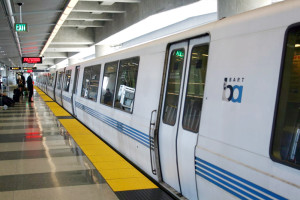
With gas prices still on the rise nationally, CSU East Bay commuters are among many who are beginning to feel the squeeze, highlighting the need for improved public transportation services in the Bay Area.
According to the U.S. Energy Information Administration, national gasoline prices are up 26 cents as of a year ago to $3.829 per gallon on average for regular unleaded gasoline.
Yet in California, that number is much higher at an average of $4.376 per gallon for regular gasoline, according to the California Energy Almanac.
On top of the exorbitant gasoline prices, Bay Area cities rank among the highest nationally for accident likelihood.
According to the “Allstate America’s Best Drivers Report” from last year, Fremont, Hayward, Oakland, San Francisco and San Jose all have relative accident likelihoods significantly greater than the national average. The Bay Area percentages range from 21.9 percent greater in San Jose to 57.3 percent over the national average in San Francisco.
Furthermore, commuters between the peninsula and the East Bay face traffic congestion that ranks seventh worst nationally. Trans-bay commuters waste an average of 50 hours a year in traffic, according to the Urban Mobility Report from 2011. The same report also lists San Jose as the 19th worst area, wasting commuters 37 hours of commuters lives per year.
Not only does it cost more to drive in California, but the risk and time wasted is comparatively higher too.
The Bay Area clearly has a number of transportation problems and lacks an adequate public transportation system to handle commuter demand.
Thankfully, just last week the Federal Transit Administration (FTA) recognized that need by committing $900 million to extend Bay Area Rapid Transit (BART) into Silicon Valley.
U.S. Transportation Secretary Ray LaHood commented in a press release, “BART will one day connect Bay Area residents with Silicon Valley entrepreneurs and the jobs they create, while reducing congestion on area highways for everyone. All across America, we have critical transportation work that needs to be done and Americans who are ready to do the work.”
The project will eventually be part of a 119-mile BART network connecting Bay Area counties in a complete loop around the bay that will be partially financed by a tax approved by Santa Clara voters.
However, even the updated system will leave BART not quite up to par.
The New York Metropolitan Transportation Authority (MTA) controls a subway system with 468 stations that easily eclipses BART’s 45 stations.
This is part of the problem with Bay Area public transportation; it is relatively inconvenient for many riders.
While this may have to do with New York City’s (NYC) approximately 27,012.5 people per square mile in comparison to the 17,179.1 people per square mile in San Francisco, using U.S. Census data, the fact still remains that many parts of the Bay Area remain unconnected.
Despite the per square mile difference, the Bay Area still has a population comparable to NYC with 7,150,739 inhabitants in the former and 8,175,133 in the latter, according to U.S. Census estimates for 2010.
Students at CSUEB definitely know how inconvenient it can be to get to and from campus without the added trouble of having limited BART stops and service hours that do not meet the needs of many students.
No one likes to get stuck in San Francisco late at night because BART isn’t running.
The FTA’s contribution is definitely a step in the right direction, but the Bay Area needs far more in order to reduce its commute problems.
Until that time, many of us will have to find more ways to economize on our commutes. We can follow the suggestions of the U.S. fuel economy website to improve mileage, but that will only get you so far.
Ultimately, Bay Area transportation has a long way to go and, even though the FTA along with the Valley Transport Authority are making headway, we must encourage any expansion of public transportation that will reduce wasted time and potential for auto collisions.











